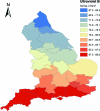Relationship of UV exposure to prevalence of multiple sclerosis in England
- PMID: 21502600
- PMCID: PMC3087404
- DOI: 10.1212/WNL.0b013e318216715e
Relationship of UV exposure to prevalence of multiple sclerosis in England
Erratum in
- Neurology. 2011 May 17;76(20):1773
Abstract
Objective: To assess the potential relationship of ultraviolet B radiation (UVB) and Epstein-Barr virus (EBV) exposure in explaining the period prevalence of multiple sclerosis (MS) in England.
Methods: English national Hospital Episode Statistics covering all admissions to National Health Service hospitals in England in the 7 years from 1998 to 2005 were used to obtain the period prevalences of MS and infectious mononucleosis (IM) in England. The United States National Aeronautics and Space Administration's data on UVB intensity for England from the Nimbus 7 satellite was collected. The relationships among the 3 variables (MS prevalence, IM prevalence, and UVB intensity) were investigated.
Results: The regression of MS against UVB intensity for all seasons had an r(2) of 0.61; when including the interaction of IM with seasonal UVB, the r(2) rose to 0.72.
Conclusions: UVB exposure and IM together can explain a substantial proportion of the variance of MS. The effect of UVB on generating vitamin D seems the most likely candidate for explaining its relationship with MS. There is a pressing need to investigate the role of vitamin D and EBV and how they might interact to influence MS risk to identify potential prevention strategies.
Figures


References
-
- Noseworthy JH, Lucchinetti C, Rodriguez M, Weinshenker BG. Multiple sclerosis. N Engl J Med 2000;343:938–952 - PubMed
-
- Ebers GC. Environmental factors and multiple sclerosis. Lancet Neurol 2008;7:268–277 - PubMed
-
- Pugliatti M, Sotgiu S, Rosati G. The worldwide prevalence of multiple sclerosis. Clin Neurol Neurosurg 2002;104:182–191 - PubMed
-
- Taylor BV, Pearson JF, Clarke G, et al. MS prevalence in New Zealand, an ethnically and latitudinally diverse country. Mult Scler 2010;16:1422–1431 - PubMed
-
- Ascherio A, Munger KL. Environmental risk factors for multiple sclerosis: part II: noninfectious factors. Ann Neurol 2007;61:504–513 - PubMed
Publication types
MeSH terms
Grants and funding
LinkOut - more resources
Full Text Sources
Other Literature Sources
Medical
